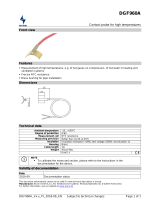
Installation and maintenance instructions ecoTEC 0020029172_042
5.8.4 Additional relay (grey plug on the PCB) and
VR40 - "2 in 7“ multifunctional module .............. 21
5.8.5 Wiring diagrams ......................................................... 22
6 Start-up .............................................................. 24
6.1 Water circulation system ......................................... 24
6.2 Filling the system ...................................................... 24
6.2.1 Preparation of heating water ................................. 24
6.2.2 Filling and bleeding from the heating side ......... 25
6.2.3 Filling the condensate siphon ................................ 26
6.3 Checking the gas setting ......................................... 26
6.3.1 Checking for tightness of the flue gas
installation and flue gas recirculation.................. 27
6.3.2 Checking the gas flow rate ..................................... 27
6.3.3 Checking the gas inlet working pressure ............ 28
6.4 Checking the appliance function ........................... 28
6.4.1 Heating ........................................................................ 29
6.4.2 Cylinder charging ...................................................... 29
6.5 Handing over the boiler to the operator ............. 29
7 Adapting the boiler to the heating
installation ......................................................... 31
7.1 Selection and setting of parameters .................... 31
7.2 Overview of adjustable system parameters ....... 31
7.2.1 Setting the heating partial load............................. 33
7.2.2 Setting of pump overrun and pump operating
mode ............................................................................. 33
7.2.3 Setting of maximum flow temperature ................ 33
7.2.4 Setting of burner anti-cycling time ....................... 33
7.2.5 Determination of maintenance
interval/maintenance display ................................. 34
8 Inspection and maintenance............................ 35
8.1 Inspection and maintenance intervals ................. 35
8.1.1 General inspection and maintenance
instructions ................................................................. 35
8.1.2 Safety instructions .................................................... 36
8.1.3 Checking the CO
2
concentration ........................... 36
8.1.4 Adjusting the CO
2
concentration (or the air
ratio) ............................................................................. 37
.8.1.5 Inspection and maintenance work steps ............. 38
8.2 Filling/draining the boiler and heating
installation .................................................................. 39
8.2.1 Filling the boiler and the heating installation .... 39
8.2.2 Draining of the boiler ............................................... 39
8.2.3 Draining the entire system...................................... 39
8.3 Maintenance of the compact thermal module ... 39
8.3.1 Dismounting the compact thermal module ........ 39
8.3.2 Cleaning the heat exchanger ................................. 40
8.3.3 Checking the burner ................................................. 40
8.3.4 Installing the compact thermal module ............... 41
8.4 Cleaning the condensate siphon ........................... 41
8.5 Cleaning the condensate ducts ............................. 42
8.6 Cleaning the air separation system ...................... 42
8.6.1 Cleaning the filter ..................................................... 42
8.6.2 Cleaning the air separator ...................................... 42
Contents
Contents
1 Notes on the documentation ........................... 3
1.1 Storage of documents .............................................. 3
1.2 Safety instructions and symbols ........................... 3
1.3 Validity of the instruction manual ........................ 3
2 Description of the boiler .................................. 4
2.1 Design .......................................................................... 4
2.2 Type summary............................................................ 5
2.3 CE label ........................................................................ 5
2.4 Benchmark .................................................................. 5
2.5 Intended use ............................................................... 5
2.6 Identification plate .................................................... 5
3 Safety instructions and regulations............... 5
3.1 Safety instructions .................................................... 5
3.1.1 Installation and setting ............................................ 5
3.1.2 Gas odour .................................................................... 5
3.1.3 Changes to the surroundings of the boiler......... 6
3.1.4 Important information regarding
propane-fired appliances ......................................... 6
3.2 General requirements .............................................. 6
3.2.1 Related documents ................................................... 6
3.2.2 Installation site .......................................................... 6
3.2.3 Gas supply ................................................................... 7
3.3 Air/flue gas duct ........................................................ 7
3.3.1 Standard 125 mm air/flue gas duct ....................... 7
3.3.2 Flue termination ........................................................ 7
3.4 Air supply .................................................................... 9
3.5 Compartment ventilation ........................................ 9
3.6 Electrical supply ........................................................ 9
4 Assembly ........................................................... 10
4.1 Scope of delivery ....................................................... 10
4.2 Accessories ................................................................. 10
4.3 Installation site .......................................................... 10
4.4 Dimension drawing and
connection dimensions ............................................ 11
4.5 Required minimum gaps/
installation clearances ............................................. 12
4.6 Using the installation template .............................. 12
4.7 Mounting the boiler .................................................. 12
4.8 Removing/attaching the front casing................... 13
5 Installation ......................................................... 13
5.1 Heating mode ............................................................. 14
5.2 Cylinder charging mode .......................................... 15
5.3 Heating mode and cylinder charging mode ....... 16
5.4 Gas connection .......................................................... 17
5.5 Heating connection ................................................... 17
5.6 Expansion relief valve (safety group), heating
installation .................................................................. 18
5.7 Condensate drainage pipework ............................. 18
5.8 Electrical connection ................................................ 19
5.8.1 Mains connection ...................................................... 19
5.8.2 Connecting controllers ............................................. 20
5.8.3 Connecting a low loss header sensor................... 21




















